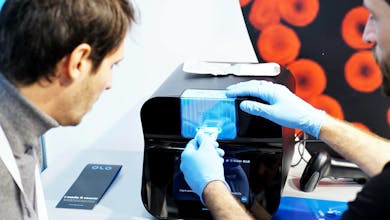Reimagining Rapid Blood Diagnostics with Oxford University Hospitals NHS Foundation Trust

For the last decade, we've been perfecting a technology that brings lab-quality diagnostics closer to the patients. At Sight, we believe common blood tests should take minutes, not hours or days, to deliver results. Having access to this type of fast, accurate and convenient testing is essential to improving our global public health. Without it, healthcare providers are slow to make triage and treatment decisions, which can severely impact patient outcomes. And, as seen with the COVID-19 pandemic, the lack of decentralized testing makes it increasingly difficult to manage the spread of a contagious disease. The pandemic accelerated the implementation of Sight’s compact Complete Blood Count (CBC) analyzer, Sight OLO in Oxford University Hospitals. Since March 2020, we've implemented five Sight OLOs across different departments to help determine the status of a patient's overall health on the spot. We spoke with Ian Smith, the Screening and Point-of-care Testing Manager in the clinical biochemistry department and Vikram Singh Lyall, Hematology POCT Senior, who have overseen Sight OLO’s implementation. They shared their perspective on how near-patient diagnostics work in practice and how it’s improved operations during this pandemic.
Meet Ian Smith & Vikram Lyall:
Q&A with Oxford’s Screening Lab Section Manager and Senior Hematology POCT Ian Smith
Ian SmithThanks for taking the time to be with us, Ian. Can you tell our readers a little more about your role and how it’s changed throughout this pandemic?
Ian Smith: Of course. At Oxford, I’m responsible for managing point of care testing, the new-born bloodspot and maternal serum screening laboratory, and we’ve faced many challenges throughout this pandemic. From a diagnostic testing perspective, the biggest change I’ve seen has been an accelerated demand for an expanded rapid testing service. Not just to support COVID testing, but also blood gas and COVID related research projects.
Why is delivering rapid diagnostics important to your work?
Ian Smith: There are four main scenarios where rapid diagnostics plays an important role:
Where the analyte is labile and will be affected by preanalytical delay. E.g. blood glucose, urine testing.
- In emergency or critical care scenarios where prompt changes to treatment are required, E.g. ITU blood gas.
- Where the time it takes to draw samples, transport them to the lab, and obtain results significantly impacts on triage decisions.
- In remote locations, such as community hospitals, where you have a time-limited window to assess patients. Having the ability to determine someone’s condition quickly helps healthcare providers make faster treatment decisions. At Oxford, we’re dedicated to providing the best patient care and we’re excited about the potential of having rapid blood diagnostics devices to help us deliver this.
 Adding Sight OLO to our armory of rapid blood diagnostics can both improve and expedite the treatment decision process for our healthcare providers.
Adding Sight OLO to our armory of rapid blood diagnostics can both improve and expedite the treatment decision process for our healthcare providers.

Why was Sight OLO chosen for Oxford’s Surgical Emergency Units (SEU)?
Ian Smith: We received a request for Complete Blood Count (CBC) point-of-care testing in the SEU to assist with the triage process in combination with other diagnostic tests (CRP, U&Es, Liver function & Amylase). We wanted to implement a simple to use CBC machine that requires little maintenance. Furthermore, if successful, the same machine would become a candidate device for use in our community and ambulatory settings. Sight OLO provides CBC results at the point-of-care in minutes. One of the main benefits of Sight OLO is that it is robust and easy to maintain. Its cartridge-based system stores all the reagents within a single cartridge. This means that it doesn’t require buffer packs or calibrations that may introduce operational errors.
Vikram Lyall: The device provides a 5-part differential along with an incorporated flagging system which is very similar to the analyzers used within the laboratory. We evaluated Sight OLO within the SEU in accordance with our validation protocol and compared Sight OLO’s performance to Sysmex machines in the laboratory. We concluded that the Sight OLO had favorable agreement across a wide range of parameters. Samples tested within the laboratory on the Sysmex analyzers were tested on the Sight OLO devices. Despite the difference in technology between the devices the results produced were well within the reproducibility and comparison ranges. This allowed us to proceed with the implementation knowing the results produced were going to be accurate.
How quickly were you able to install Sight OLO?
Ian Smith: The first device took some time to implement, which is expected since we wanted to do it right. Subsequent devices were much easier and faster to install. Sight provides ample training and support to ensure the system is set up correctly. Now we’re able to run a cascade learning pathway, where one person can train other users, and the entire process takes less than 30 minutes.
Vikram Lyall: The ward staff were a little hesitant at first due to the small amount of pipetting required (which is natural as they are not trained in such techniques). However they are now fully competent and confident. The small amount of blood required for testing is extremely beneficial given some patients are very difficult to bleed.
 Samples tested within the laboratory on the Sysmex analyzers were tested on the Sight OLO devices. Despite the difference in technology between the devices the results produced were well within the reproducibility and comparison ranges.
Samples tested within the laboratory on the Sysmex analyzers were tested on the Sight OLO devices. Despite the difference in technology between the devices the results produced were well within the reproducibility and comparison ranges.
What are the key barriers to realizing the point-of-care diagnostic transformation?
Ian Smith: One of the main barriers is training staff and the upfront costs. Introducing a new technology requires a significant investment in training resources and time to up-level staff members and ensure they have confidence in the results. But with any new technology, it has to be part of a more integrated, long-term strategy. When fully adopted, point-of-care testing can improve the patient pathway, which ultimately leads to cost-savings in the long-run.
What’s the impact of adding a device like Sight OLO to Oxford University Hospitals?
Ian Smith: Adding Sight OLO to our armory of point-of-care diagnostics can both improve and expedite the treatment decision process for our healthcare providers.
Vikram Lyall: CBC is a universal test that is important both as a diagnostic and patient management tool. Before administering chemotherapy for example, providers need to conduct a CBC test to ensure patient’s white blood cell counts are at the proper levels to receive the treatment.
Ian Smith: For our surgical unit, Sight OLO is improving the assessment time for patients undergoing triage and it may potentially help us with similar decisions in ED and Emergency multidisciplinary units.
Vikram Lyall: The pandemic has really challenged our hospitals to re-envision how care is delivered in the ED and we’ve put a big focus on rapidly assessing a patients’ overall health upon entry to triage them quickly to appropriate care. The NHS imposes waiting time standards, which can result in hefty fines if breached. So having rapid CBC results not only improves efficiency in care delivery, but it also is saving the hospitals several thousands of pounds in avoided fees. Sight OLO is absolutely critical in reducing care delays and supporting infection control at our hospitals.
